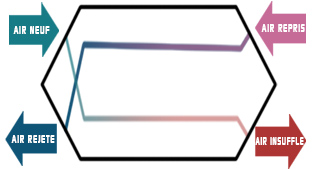Comparative between a counterflow plate exchanger or rotary exchanger for double flow ventilation
What are the 3 types of ventilation exchangers?
-
Cross-plate exchanger
These are older models, which have been used a lot but tend to disappear. The thermal efficiency is around 70%.
-
Countercurrent exchangers:
Achieving an efficiency around 90%, they are an evolution of the cross-plate exchangers. The air flows cross each other but also flow in the opposite direction
- .
-
Rotating exchangers
A wheel rotates within the exchanger, hence the name "rotary". This ensures the transfer between fresh air and stale air.
When the system incorporates a purge to avoid significant air recirculation, in this case it is an enthalpy exchanger: they also recover latent heat. In case of humidity, especially in air-conditioned buildings, this can be of interest.
The efficiency is in the order of 80 to 85%.
Focus on the counterflow plate heat exchanger
The counterflow plate heat exchanger equips the majority of bifurcated boxes with high efficiency (>90%).
- .
- The supplied air drawn into the service rooms of the dwelling (kitchen, bathroom, WC, other shower room) crosses in the opposite direction the flow of new outside air to be blown into the living rooms (living room, bedroom, office...).
- The new air recovers the calories of the extracted air without mixing with the extracted air.

Contrary to popular belief, the synthetic heat exchanger is more efficient than the metal heat exchanger.
. In fact, in the polypropylene countercurrent exchanger, the calories of the return air and the supply air are kept on the same side of the exchanger (see image) thanks to the high thermal resistance of the material.
The temperature of an aluminium exchanger for example would be much more homogeneous between the inlet and the outlet. This reduces the maximum temperature to be recovered for the air to be blown in.
Focus on the rotary exchanger
The general principle of the rotary exchanger is based on heat recovery by accumulation.
.
The extracted hot air passes through a moving wheel and heats the wheel material. As it continues to rotate, the heated wheel passes through the fresh air stream to be blown in and heats it up.
The energy recovery efficiencies are good, they can go over 80%.
.
The rotary exchanger also recovers moisture from the extracted air and limits the drying out of the indoor air when it is very cold.
This type of exchanger does not require an electric frost protection coil or condensate drain.
.
This technology is widely used in Scandinavian countries.
.
Find out more:
We invite you to discover our 7 criteria for choosing your vmc, understand the functioning of your vmc fans as well as our advice for your ducts and vmc network
Would you like a free study of your vmc project? Our team is here to help you with your project.
